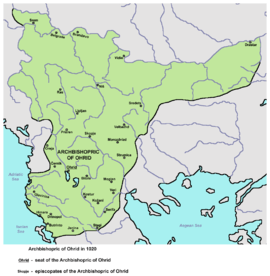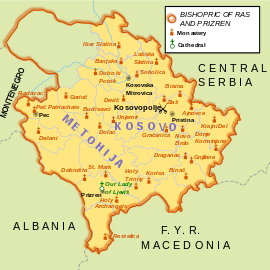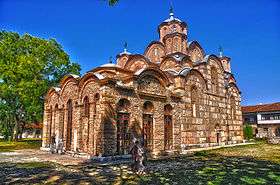Eparchy of Lipljan



Eparchy of Lipljan, later known as Eparchy of Gračanica or Eparchy of Novo Brdo (Serbian: Епархија липљанска, Eparhija lipljanska) is one of the former historical eparchies in the central parts of Kosovo region. Today it is part of Serbian Orthodox Eparchy of Raška and Prizren.
History
Under the jurisdiction of Justiniana Prima
Eparchy of Lipljan was one of the oldest eparchies in the region. Modern name of the city of Lipljan was derived from the name of its predecessor, the ancient Roman city of Ulpiana.[1] The city was founded in 1st century BC and soon it became one of the most important cities in the Roman province of Moesia and its successor province of Dardania.[2] The ancient Bishopric of Ulpiana was situated near the modern town of Lipljan where the remains of episcopal Basilica dating from the first half of 6th century have been found and excavated. The exact date of the foundation of Bishopric of Ulpiana is not known, but some of the bishoprics in the nearby regions were erected as early as 4th century.[3]
After the Eastern–Western Roman split, the city of Ulpiana with rest of Dardania remained part of the Eastern Roman or Byzantine Empire.[4] Up to the beginning of 6th century, episcopal see of Ulpiana was already under supreme jurisdiction of Archbishopric of Thessaloniki, and in 535 it was transferred by the decree of emperor Justinian I (527-565) to newly created Archbishopric of Justiniana Prima.[5] In honor of the Emperor, Ulpiana was named "Iustiniana Secunda". Byzantine rule in that region finally collapsed at the beginning of 7th century and the church life was later renewed after the Christianization of Serbs.[6]
Under the jurisdiction of Archbishopric of Ohrid
After the successful Byzantine conquests of 1018 and the establishment of imperial rule in Bulgarian and Serbian lands, by the order of emperor Basil II a new and autonomous Archbishopric of Ohrid was created in 1019, under the supreme ecclesiastical jurisdiction the Patriarchate of Constantinople.[7] Imperial charters of 1019 and 1020 mention the Bishopric of Lipljan among eparchies under the jurisdiction of the autonomous Archbishopric of Ohrid.[8] Until the beginning of 13th century, archbishops of Ochrid were titled as metropolitans of all Bulgaria and Serbia.
During 11th and 12th century Byzantines and Serbs fought several battles over the city of Lipljan. Sometime between 1185 and 1195, during the rule of Serbian "grand župan" Stefan Nemanja (1168-1196), Byzantine Empire finally ceded Lipljan to Serbia, but Eparchy of Lipljan still remained under the ecclesiastical jurisdiction of the Archbishipric of Ohrid.[9]
Under the jurisdiction of Serbian Orthodox Church
The autocephaly of Orthodox Church in medieval Serbia was established in 1219 by Saint Sava who was consecrated as first Serbian archbishop by the Byzantine patriarch residing at that time in Nicaea. Since then, Eparchy of Lipljan was under the constant jurisdiction of Archbishop of Serbia.[10][11] During 13th century, bishops of Lipljan known by name were: Mavrojan, Varnava, Sava and Jovan. Eparchy had jurisdiction over counties of Lipljan, Binačka Morava and Topolnica.[12] At the beginning of the 14th century, bishops of Lipljan were Antonije and Ignjatije.[13] In that time, during the final years of the reign of Serbian king Stefan Milutin (1282-1321), the grand complex of the Monastery of Gračanica was built as the seat for bishops of Lipljan.[14]
In 1346, Serbian Archbishopric was raised to the rank of Patriarchate with its see remaining in Peć. At the same time the Eparchy of Lipljan was raised by title to the rank of Metropolitanate. Bishops of Lipljan kept under their jurisdiction the region of central Kosovo with Gračanica and Novo Brdo. Period from the beginning of 13 century to the end of 14 century was the golden age for Orthodox Church in the region of central Kosovo with many monasteries and churches built by Serbian rulers and local Serbian nobility. In the middle of 14th century Bishop of Lipljan was Teodor, and second half od 14th century, metropolitan of Lipljan was Simeon. In the first half of 15th century metropolitans of this eparchy were Dionisije and Dositej.[15]
In the time of Turkish conquests, in the middle of 15th century, Serbian Orthodox Church suffered great devastation. Region of Kosovo finally fell under Turkish rule around 1455. Metropolitan Venedikt of Lipljan had to flee from his eparchy, finding refuge at the Court of Serbian Despot Đurađ Branković in Smederevo.[16][17] By the beginning of 15th century, Eparchy of Lipljan was returned to the jurisdiction of Archbishopric of Ohrid. In the first half of 16. century, metropolitan of Lipljan was Nikanor (around 1530-1545).[18]
Serbian Patriarchate was renewed in 1557 by patriarch Makarije Sokolović.[19] In that time (16th–18th century), Eparchy of Lipljan remained under constant jurisdiction of Serbian Patriarchate.[20] In the second half of 16th century, metropolitans of Lipljan were Dionisije (around 1570) and Vasilije (around 1587-1598). In 1614, Metropolitan Pajsije of Lipljan became Serbian Patriarch. After him, Metropolitan of Lipljan was Longin (1616).[21][22]
Two major events of that time tragically impacted Orthodox Church in the region of central Kosovo. During the Austro-Turkish war (1683–1699) relations between local Muslims and Christians in European provinces of Ottoman Empire were radicalized. As a result of Turkish oppression, destruction of Churches and Monasteries and violence against non-Muslim civilian population, Serbian Christians and their church leaders headed by Serbian Patriarch Arsenije III sided with Austrians in 1689 and again in 1737 under Serbian Patriarch Arsenije IV.[23] In the following punitive campaigns, Turkish armies conducted systematic atrocities against local Christian population in Serbian regions, including central parts of Kosovo region, resulting in Great Migrations of the Serbs.[24]
One of the consequences of devastation and depopulation in the regions of central Kosovo during austro-Turkish wars was the reorganization of local Serbian eparchies. At the beginning of 18th century, the old Eparchy of Lipljan (with Gračanica and Novo Brdo) was merged with the Eparchy of Prizren and they remained united to the present day.[21] In honor to the old Eparchy of Lipljan, auxiliary bishops in modern Eparchy of Raška and Prizren are bearing the title "Bishop of Lipljan"
Bishops and Metropolitans of Lipljan
This is an incomplete list of bishops and metropolitans of Lipljan.[25]
- Mavrojan (13th century)
- Varnava (13th century)
- Sava (13th century)
- Jovan (13th century)
- Antonije (beginning of 14th century)
- Ignjatije (first half of 14th century)
- Teodor (middle of 14th century)
- Simeon (around 1383-1388)
- Dionisije (first half of 15th century)
- Dositej (first half of 15th century)
- Venedikt (around 1455)
- Nikanor (around 1530-1545)
- Dionisije (around 1570)
- Vasilije (around 1587-1598)
- Pajsije (1612-1614)
- Longin (around 1616)
References
- ↑ Papazoglu 1978, p. 224-231.
- ↑ Petrović 2007, p. 13.
- ↑ Harnack 1905, p. 371, 375.
- ↑ Mócsy 2014, p. 350.
- ↑ Јанковић 1983, pp. 31.
- ↑ Curta 2001, pp. 125, 130.
- ↑ Stephenson 2000, pp. 74-75.
- ↑ Bulić 2013, pp. 221-222.
- ↑ Јанковић 1983, pp. 27.
- ↑ Јанковић 1983, pp. 29.
- ↑ Ćirković 2008, pp. 40-43.
- ↑ Јанковић 1985, pp. 112-119.
- ↑ Јанковић 1983, pp. 29-30.
- ↑ Ивановић 1961, pp. 253-264.
- ↑ Јанковић 1983, pp. 30-31.
- ↑ Ćurčić 1979, pp. 20.
- ↑ Јанковић 1983, pp. 36.
- ↑ Ćurčić 1979, pp. 20-21.
- ↑ Ćirković 2008, pp. 135-137.
- ↑ Ćirković 2008, pp. 177.
- 1 2 Грујић 1993, pp. 130.
- ↑ Ćurčić 1979, pp. 23-24.
- ↑ Ćirković 2008, pp. 144, 244.
- ↑ Pavlowitch 2002, pp. 19-20.
- ↑ Јанковић 1985, pp. 147-149.
Sources
- Harnack, Adolf (1905). The Expansion of Christianity in the First Three Centuries. 2. New York: Putnam's Sons.
- Zeiller, Jacques (1918). Les origines chrétiennes dans les provinces danubiennes de l'Empire romain. Paris: E. De Boccard.
- Ивановић, Радомир (1961). "Земљишни поседи грачаничког властелинства (Land Property of the Monastery Gračanica in Middle Ages)". Историјски часопис (11: 1960): 253–264.
- Papazoglu, Fanula (1978). The Central Balkan Tribe in Pre-Roman Times: Triballi, Autariatae, Dardanians, Scordisci and Moesians. Hakkert. ISBN 978-90-256-0793-7.
- Ćurčić, Slobodan (1979). Gračanica: King Milutin's church and its place in late Byzantine architecture. Pennsylvania State University Press.
- Јанковић, Марија (1983). "Липљанска епископија и Грачаничка митрополија (The Lipljan Bishopric and the Metropolitanate of Gračanica)". Историјски часопис (29-30: 1982-1983): 27–37.
- Јанковић, Марија (1985). Епископије и митрополије Српске цркве у средњем веку (Bishoprics and Metropolitanates of Serbian Church in Middle Ages). Београд: Историјски институт САНУ.
- Грујић, Радослав (1993). Азбучник Српске православне цркве. Београд: БИГЗ, Музеј СПЦ.
- Вуковић, Сава (1996). Српски јерарси од деветог до двадесетог века (Serbian Hierarchs from the 9th to the 20th Century). Евро, Унирекс, Каленић.
- Stephenson, Paul (2000). Byzantium's Balkan Frontier: A Political Study of the Northern Balkans, 900-1204. Cambridge University Press.
- Curta, Florin (2001). The Making of the Slavs: History and Archaeology of the Lower Danube Region, c.500–700. Cambridge University Press. ISBN 978-1-139-42888-0.
- Pavlowitch, Stevan K. (2002). Serbia: History behind the name. C. Hurst & Co. Publishers.
- Popović, Svetlana (2002). "The Serbian Episcopal sees in the thirteenth century (Српска епископска седишта у XIII веку)". Старинар (51: 2001): 171–184.
- Живковић, Тибор (2004). Црквена организација у српским земљама: Рани средњи век (Organization of the Church in Serbian Lands: Early Middle Ages). Београд: Историјски институт САНУ, Службени гласник.
- Petrović, Vladimir P. (2007). "Pre-Roman and Roman Dardania: Historical and Geographical Considerations" (PDF). Balcanica. Balkanološki institut SANU. no. 37.
- Ćirković, Sima (2008). The Serbs. John Wiley & Sons.
- Bulić, Dejan (2013). "The Fortifications of the Late Antiquity and the Early Byzantine Period on the Later Territory of the South-Slavic Principalities, and their re-occupation". The World of the Slavs: Studies of the East, West and South Slavs: Civitas, Oppidas, Villas and Archeological Evidence (7th to 11th Centuries AD). Istorijski institut SANU. pp. 137–234. ISBN 978-86-7743-104-4.
- Mócsy, András (2014) [1974]. Pannonia and Upper Moesia (Routledge Revivals): A History of the Middle Danube Provinces of the Roman Empire. Routledge. ISBN 978-1-317-75425-1.
Further reading
- Đorđe Janković, Kosovo And Metohia In The Middle Ages – Archaeological Research
- Sima Ćirković, Rises and falls in Serbian statehood in the Middle Ages
- Radoš Ljušić, The centuries under Turkish rule and the revival of Serbian statehood
- Milovan Radovanović Kosovo and Metohia – A Geographical and Ethnocultural Entity in the Republic of Serbia
- Dušan Bataković, The Kosovo Chronicles
- Crucified Kosovo: Destroyed and desecrated Serbian Orthodox churches in Kosovo and Metohia (June–October 1999)
- Old Serbia and Albanians
External links
- The Princeton Encyclopedia of Classical Sites: Ulpiana
- Official site of the Eparchy of Raška and Prizren
- Official site of the Serbian Orthodox Church
- List of Cultural Monuments in Serbia
- Project Rastko: Kosovo and Metohija
- Monasteries of the Eparchy of Raška and Prizren

